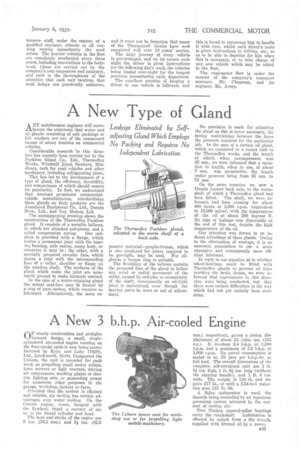A New Type of Gland
Page 59

If you've noticed an error in this article please click here to report it so we can fix it.
Leakage Eliminated by Selfadjusting Gland Which Employs No Packing and Requires No Independent Lubrication
ANY maintenance engineer will corroborate the statement that water and oil glands consisting of soft packings or felt washers are one of the commonest causes of minor troubles on commercial vehicles.
Considerable research in this direction has recently been carried out by the Packless Gland Co., Ltd., Thermoflex Works, Windmill load, Sunbury, Middlesex, both for road vehicles and other machinery, including refrigerating plant.
This has led to the development of a type of gland, the efficiency, durability, and compactness of which should ensure its popularity. In fact, we understand that amongst prominent commercialvehicle manufacturers, standardizing these glands on their products are the Associated Equipment Co., Ltd., Dennis Bros., Ltd., and Guy Motors, Ltd.
The accompanying drawing shows the construction of the Thermoflex Packless gland. It consists of a metallic bellows, to which are attached end-pieces, and a
coiled compression spring. One endpiece is provided with a flange, which makes a permanent joint with the beartug housing, axle casing, pump body, or whatever it may be ; the other, with a specially prepared annular face, which makes a joint with the corresponding face of a collar, shoulder or flange on the rotating shaft. The surfaces of the gland which make the joint are accurately ground to make intimate contact.
In the case of a water-retaining gland the actual seal-face may be formed by a ring of pure carbon, which requires no lubricant. Alternatively, the more ex pensive material—grapho-bronze, Which is also employed for joints required to be gas-tight, may be used. For oilglands a bronze ring is suitable.
The flexibility of the bellows permits the prepared face of the gland to follow any axial or radial movement of the collar, caused by end-play or eccentricity of the shaft, consequently an oil-tight joint is maintained, even though the moving parts be worn or out of adjustment.
No provision is made for adjusting the gland as this is never necessary, the spring maintaining between the faces the pressure required for the particular job. In the case of a certain oil gland, which we examined on a recent visit to the Thermoflex works, and the length of which, when uncompressed, was 85 mm., we were informed that a variation in length, when in use, of about 7 ram. was permissible, the length under pressure being from 65 mm. to 72 ram.
On the same occasion we saw a Dennis Lancet back axle, to the wormshaft of which a Thermoflex gland had been fitted._ The shaft, we were informed, had been running for about 400 hours at 3,000 r.p.m. (equivalent to 16,000 miles), with the temperature of the oil at about 200 degrees F. No sign of leakage was discernible at the end of this test, despite the high temperature of the oil.
Our attention was drawn to an indirect advantage of these glands. Owing to the elimination of wastage, it is an economic proposition to use a more expensive and consequently more efficient lubricant.
In reply to our question as to whither wheel-bearings could be fitted with Thermoflex glands to prevent oil from reaching the brake drums, we were informed that experiments in this direction were being conducted, but that there were certain difficulties in the way which had not yet entirely been overcome.




























































































